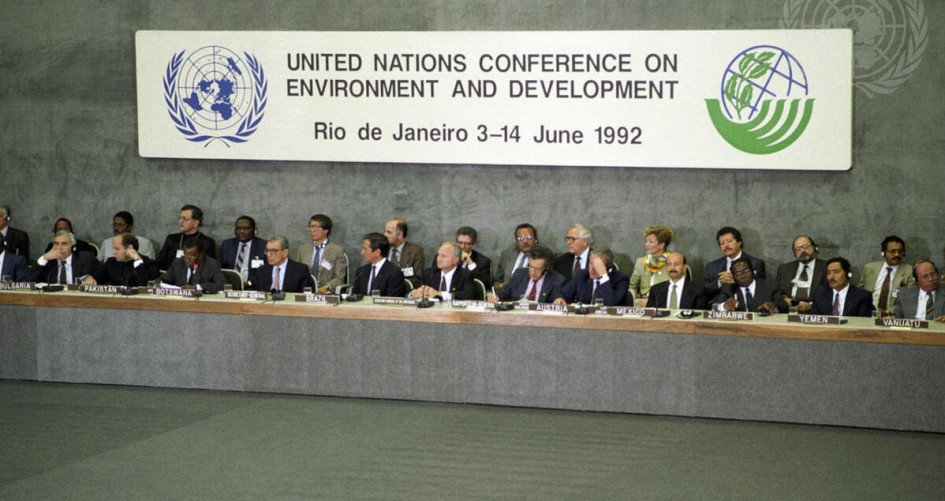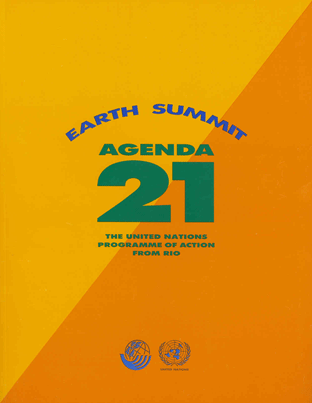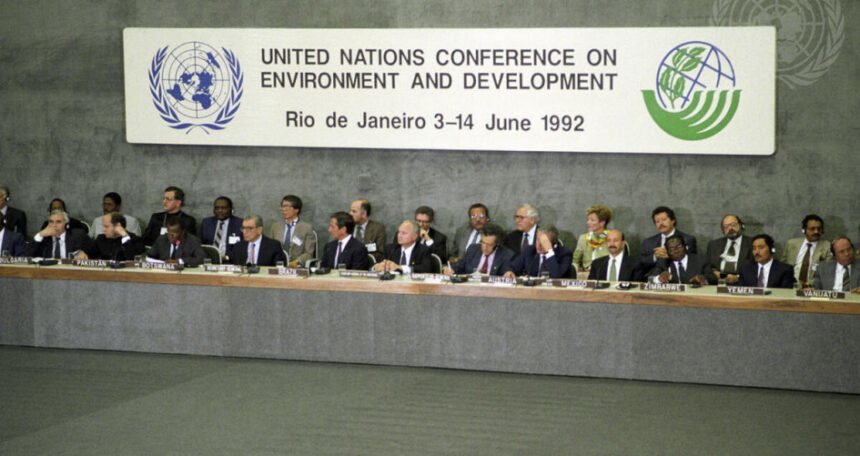Introduction:
The Earth Summit 1992, officially known as the United Nations Conference on Environment and Development (UNCED), was a pivotal event in the history of international environmental diplomacy.
Held in Rio de Janeiro, Brazil, from June 3 to June 14, 1992, it marked the largest gathering of world leaders at the time, intending to address urgent problems of environmental protection and socio-economic development.

This summit laid the groundwork for future policies and set a new agenda for global environmental governance.
Background of the Earth Summit:
The Earth Summit was the culmination of growing global awareness about environmental issues that began in the 1960s and 1970s. It built on the foundation laid by the United Nations Conference on the Human Environment held in Stockholm, Sweden in 1972, which was the first major international conference on environmental issues.
People from different fields from 179 countries gathered to create a massive effort toward protecting the environment. A Global Forum of NGOs was also held at the same venue same time.
Goals of the Summit:
The primary objectives of the Earth Summit were to encourage sustainable development through the integration of environmental and developmental concerns, promote fair and equitable access to resources for all, and establish a global partnership for environmental protection.
Key Achievements:
● Key Achievements:

One of the summit’s major outcomes was the adoption of Agenda 21, a comprehensive plan of action to be taken globally, nationally, and locally by organizations of the United Nations, governments, and major groups in every area in which humans impact the environment.
Agenda 21 set the stage for a sustainable development strategy that was unprecedented in scope and significance. One of its major objectives is that every local government should prepare its own local Agenda 21.
● The Rio Declaration:
The Rio Declaration on Environment and Development is a series of 27 principles calling for a global partnership to address environmental issues and promote sustainable development.
Among its principles are the concepts of states’ responsibility to ensure that activities within their borders do not cause environmental damage outside their borders, and the idea that development must consider environmental protection.
● Organizations Launched by the Convention:
The summit also led to the creation of three major conventions aimed at combating climate change, biodiversity loss, and desertification.
These were –
Each of these played a crucial role in shaping international environmental policy and practice in the years that followed.
● The United Nations Framework Convention on Climate Change (UNFCCC):
Aimed at stabilizing atmospheric concentrations of greenhouse gases to prevent dangerous interference with the climate system. It laid the groundwork for future agreements on climate change, including the Kyoto Protocol and the Paris Agreement.
● The Convention on Biological Diversity (CBD):
An international treaty with three main goals: the conservation of biological diversity, the sustainable use of its components, and the fair and equitable sharing of the benefits arising from genetic resources. It has been influential in promoting global biodiversity conservation efforts.
● The United Nations Convention to Combat Desertification (UNCCD):
Established to address desertification and mitigate the effects of drought through national action programs that incorporate long-term strategies supported by international cooperation and partnership arrangements.
Other Achievements:
● The Statement of Forest Principles:
A non-legally binding agreement that sets forth principles for the sustainable management of forests worldwide. It emphasizes the need to manage forest resources to meet the social, economic, ecological, cultural, and spiritual needs of current and future generations.
● The establishment of the Commission on Sustainable Development (CSD):
Created to ensure effective follow-up of UNCED, and monitor and report on implementation of the Earth Summit agreements at the local, national, regional, and international levels.
● The launch of the Global Environment Facility (GEF):
Although established before the Earth Summit as a pilot program, the GEF was restructured after UNCED to serve as a financial mechanism for five major international environmental conventions, including the UNFCCC and CBD, providing grants to developing countries for projects related to biodiversity, climate change, land degradation, international waters, and the ozone layer.
Challenges:
The Earth Summit 1992, while a landmark event in the global environmental movement, was not without its disputes and controversies.

● North-South Divide:
One of the most significant disputes was between the wealthier, industrialized nations of the North (western Europe and North America) and the developing countries of the South (Africa, Asia, South America, and the Middle East).
Developing countries were concerned about the potential restrictions on their economic development and demanded new financial resources and technology transfer to help them achieve sustainable development without compromising their growth.
● Financial Commitments:
Developing nations argued for increased financial support from developed countries to help them implement environmental protection measures.
The disagreement over the size and mechanisms of this financial support was a sticking point, with developed countries wary of committing to large, unspecified sums.
● Binding Targets for Greenhouse Gas Emissions:
There was considerable debate over whether to include legally binding targets for the reduction of greenhouse gas emissions. Many developed countries, especially the United States, were opposed to mandatory limits.
This led to the adoption of a more flexible, non-binding approach in the UN Framework Convention on Climate Change (UNFCCC).
● Principle of Common but Differentiated Responsibilities:
This principle, which became a cornerstone of the Rio Declaration, acknowledges that while all countries are responsible for environmental protection, they have different capabilities and levels of development.
The interpretation and implementation of this principle were contentious, with developed countries concerned about the economic implications of taking on the bulk of responsibilities.
● Biodiversity and Intellectual Property Rights:
The Convention on Biological Diversity (CBD) faced disputes over issues related to intellectual property rights and the sharing of benefits from the use of genetic resources.
Developed countries, with advanced biotechnological capabilities, and developing countries, rich in biodiversity, had differing views on access to genetic resources and the sharing of benefits.
● Trade and Environment:
There were concerns about the potential conflict between environmental agreements and the rules of international trade.
Developing countries were particularly worried that environmental measures could be used as a form of green protectionism to restrict their exports.
Despite these disputes, the Earth Summit succeeded in raising global awareness about environmental issues and set the stage for future negotiations and agreements.
Conclusion:
The Earth Summit 1992 was a landmark event in the history of environmental diplomacy, setting the stage for future efforts to address the planet’s pressing environmental challenges.
Its ambitious agenda and the conventions it spawned have had a lasting impact on global environmental governance, serving as a reminder of the importance of international cooperation in safeguarding the Earth for future generations.
Paris Agreement:
The Kyoto Protocol of 1997 was suspended by the Paris Agreement on Climate Change of 2015. This treaty was adopted in December 2015 in Paris, France.
Paris Agreement aimed to reduce greenhouse gas emissions which contribute to global warming. It was signed by 195 countries and came into force in November 2016. Paris Agreement was ratified in January 2021 by 190 countries.
France hosted the United Nations Climate Change Conference (UNCCC) in 2015 with representatives from 196 nations. The main objective was to prepare a blueprint to limit greenhouse gas emissions to control global temperature rise that is much faster than in the Pre-Industrial Revolution era.





